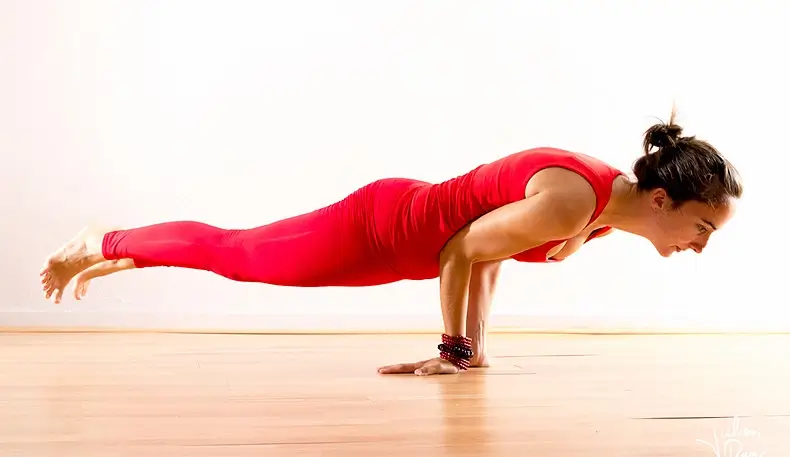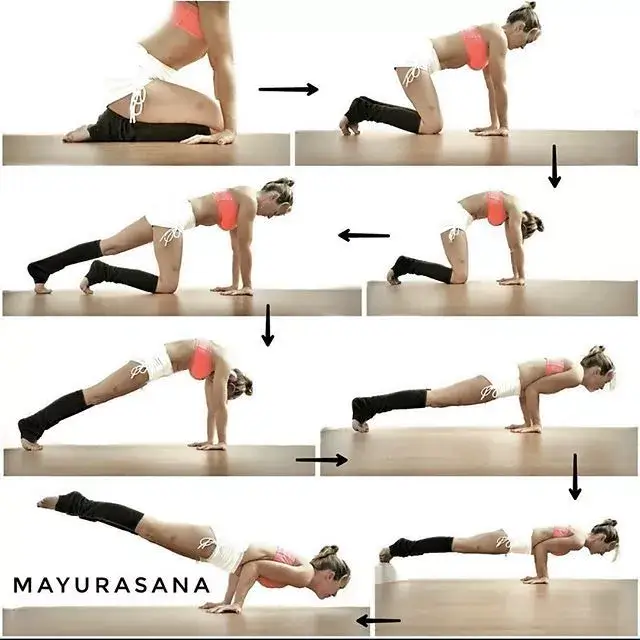Origins of Mayurasana
Name in Sanskrit :
मयूरआसन
Name in English :
Peacock Pose
Areas of Action :
Arms, Wrists & Forearms
Level :
Advanced
20 Min Yoga Self-Help PDF For Beginners
Mayurasana is one of the ancient yoga forms in Hatha yoga. The word Mayurasana is derived from two Sanskrit words “Mayur” (मयूर) meaning peacock and “Asana” (आसन) which refers to posture.
This is a traditional and a non-seated asana. This asana is called Mayurasana because when you do this pose, you looks like a peacock walking steadily with its feathers downwards.In this asana, the practitioner's body is in a similar like holding a horizontal rod on the floor with your palms and at the same time the body is supported on the ground with help of your elbows.

The Peacock Pose looks complicated but in reality its not very difficult.
If you want to practice this asana properly, even if you are a beginner, the guidelines in this article will help you achive your goal. I will explain all the steps of doing Mayurasana and the benefits you can gain by practicing it regualarly.
How to perform Mayurasana?
Important tips to keep in mind before practising Mayurasana
Before going further, I would like to give you some important tips that are going to be very helpful -
- While practicing Mayurasana, your stomach or bowel should be empty, make sure you have eaten at least 5 to 6 hours before you practice this yoga asana.
- It is necessary so that you manage to keep enough strength to perform this asana after proper digestion of your meal.
- This yoga asana can be done in both morning and evening. It takes around 30 to 60 seconds to perform this asana.
Let's check out the steps to perform The Peacock Pose -
1. First, start by sitting on your heels and ensure that your knees have enough space so both knees are not touching each other.
2. Put your hands on the floor and in such a way that your fingers point towards your body. Then try to bend your elbow smoothly and push down them towards your abdomen.
3. For the next step, keep your belly as tight you can. While doing this, put your head on the floor at ease.

4. Lie down in such a way that your knees are as straight as an arrow and top part of your feet are just facing the floor.
5. You should keep your shoulder blades strong and press into your back. Strengthen your buttock and lift your head and look in forward direction.
6. Bring your body weight forward and lift up your legs from the floor. Make sure that your body must be aligned to the floor with all the weight on your hands.

7. This is the final step of Mayurasana. Pause in this position for 10 seconds. If you practice it regularly then you can hold it for up to 1 minute.
8. Finally, relax right after dropping your head and feet on the floor gradually.
Mayurasana Benefits
Here, I have described some of the surprising benefits of doing Mayurasana. Please take a brief look-
- According to Yoga Guru B.K.S. Iyenger, this posture builds up the abdominal’s body organs amazingly. This elbow force on the abdominals aorta helps to make blood circulation proper in the abdominal organs.
- B.K.S. Iyengar also claimed that this posture also improves digestion, prevents toxins from congregating, cures spleen, and stomach illness. He also claimed that it also benefits a disease like diabetes.
- The Gherenda Samhita describes that Mayurasana pose helps to detoxifies the toxins from the body.
- It also helps to boost the muscle strength of the elbow, spine, wrist, and shoulders.
- This pose improves your body postures.
- It enhances your concentrations and establishes coordination between body and mind.
- Like other yoga asanas, this asanas also helps in releasing stress and anxiety.

Mayurasana Variations
Hamsasana (Swan Pose)
Hamsasana is one of the variation of the Peacock Pose. When you perform this yoga posture, you look like a swan. This posture is a great way to strengthen your arms, wrists and abdominal muscles.
Padma Mayurasana (Lotus in Peacock Poses)
This pose is an advanced varition of Mayurasana. It is performed by first sitting in the Padmasana (Lotus Pose) and then performing the Mayurasana. Apart from strengthening arms and wrists, the Padma Mayurasana helps with digestiona & is a great yoga pose for constipation.
Things to Keep in Mind When Practicing Triangle Pose
Don’t do this asana, if you are having the following conditions-
- Menstruation
- Problems in intestines
- High blood pressure
- Brain tumor
- Pregnancy
- Hernia
- Piles or fisher
- Eye, nose and ear infections
- If you are going through wrist, elbow, or shoulders injuries, then this is better for you to avoid this practice.
- Any discomfort while performing this asana like restlessness, severe pain, etc. therefore stop continuing this asana immediately.
Now that you know all this new information about Mayurasana, its time to practice. If you are a beginner, you need to take care and extra cautions while practicing you can also start with easy steps like Gomukhasana. Your mind needs patience to make out a balance with your body, and once you achieve this state, you will be able to gain all the benefits that this amazing yoga pose has to offer.
Join Yoga Teacher Training in Rishikesh
Check out 200 hour yoga teacher training in Rishikesh 500 hour yoga teacher training in rishikesh, 300 hour yoga teacher training in Rishikesh at 7 chakras Yoga School in Rishikesh